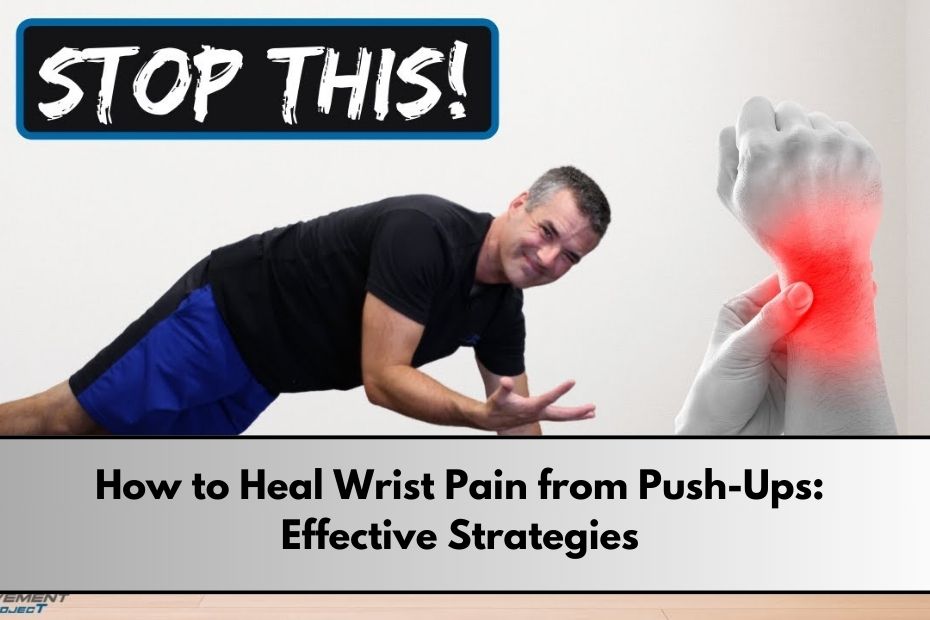How to Heal Wrist Pain from Push-Ups: Experiencing wrist pain during or after push-ups is a common issue that can hinder your workout routine and overall fitness progress. Understanding the causes of this pain and implementing effective strategies for healing is essential for maintaining your exercise regimen. Here are some insights and practical steps to help you heal wrist pain caused by push-ups.
Understanding the Causes of Wrist Pain
Poor Wrist Mobility: Limited wrist mobility can lead to excessive stress on the joint during push-ups, resulting in discomfort. Insufficient wrist extension may be a significant contributing factor, often exacerbated by previous injuries or inadequate warm-up routines.
Incorrect Technique: Performing push-ups with improper form can place undue strain on the wrists. Common mistakes include excessive wrist extension or flexion, incorrect hand placement, and shifting weight excessively towards the fingers. Ensuring proper alignment and technique is crucial for minimizing pain.
Weak Forearm Muscles: Insufficient strength in the forearm muscles, particularly the wrist flexors and extensors, can lead to pain during push-ups. Weakness in these muscles may result from lack of conditioning or excessive typing and gripping activities.
Pre-existing Conditions: Conditions such as carpal tunnel syndrome, tendinitis, or arthritis can make your wrists more susceptible to pain during push-ups. If you have a history of wrist injuries or these conditions, it’s essential to exercise caution and seek professional advice.
Strategies to Heal Wrist Pain
Warm-Up and Stretching: Before performing push-ups, it’s crucial to warm up your wrists and surrounding muscles. Engaging in wrist-specific stretches and mobility exercises can increase blood flow and improve joint range of motion. Spend 5-10 minutes warming up your wrists with exercises like finger pulses, reverse palm elbow rotations, and backward palm rocks.
Gradual Progression: If you experience wrist pain during push-ups, start with modified variations that decrease the load on your wrists. For example, perform push-ups on an elevated surface like a bench or step to reduce strain. Gradually progress to standard push-ups as your strength and comfort improve.
Optimal Hand Placement: Ensure that your hands are slightly wider than shoulder-width apart and aligned with your shoulders during push-ups. Maintain a neutral wrist position with fingers pointing forward or slightly outward to avoid excessive extension or flexion.
Use Alternative Techniques: Consider using parallel bars or performing push-ups on your knuckles to keep your wrists straight while exercising. This modification can help alleviate pressure on the wrists while still engaging the chest and arm muscles effectively.
Strengthening Exercises: Incorporate exercises that strengthen the forearm muscles to support your wrists better. Wrist curls, reverse wrist curls, and grip-strengthening exercises can enhance muscle endurance and stability in the wrists over time.
Rest and Recovery: Allow adequate time for rest and recovery if you experience persistent pain. Overworking your wrists can exacerbate injuries; therefore, listen to your body and take breaks as needed.
Consult a Professional: If wrist pain persists despite implementing these strategies, consider consulting a healthcare professional or physiotherapist for a thorough assessment. They can provide targeted treatment options, including manual therapy, specific exercises for mobility improvement, and personalized advice tailored to your condition.
Conclusion
Healing wrist pain from push-ups requires understanding its underlying causes and taking proactive steps to address them. By warming up properly, using modified techniques, optimizing hand placement, strengthening forearm muscles, allowing for rest, and seeking professional guidance when necessary, you can effectively manage and alleviate wrist pain while continuing to build upper body strength through push-ups. Prioritizing wrist health will not only enhance your performance but also contribute to long-term fitness success.
FAQ’s
What causes wrist pain during push-ups?
Wrist pain can be caused by poor wrist mobility, incorrect technique, weak forearm muscles, or pre-existing conditions like arthritis or tendinitis.
How can I reduce wrist pain during push-ups?
To reduce wrist pain, try warming up with stretches, using proper hand placement, modifying your technique, and incorporating strengthening exercises for your forearms.
When should I consult a professional for wrist pain?
If wrist pain persists despite following these strategies, it’s best to consult a healthcare professional or physiotherapist for a thorough assessment and targeted treatment.

